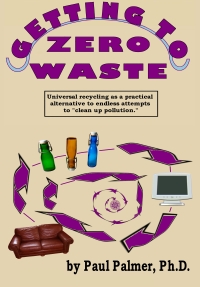 Scroll down for purchase instructions Scroll down for purchase instructions |
This is a book that analyzes the current state of recycling and our system of garbage and finds it wanting.The book bursts open the constricted set of self defeating procedures that have come to be known as diversion and recycling and shows you how a civilized society would deal with its excesses. This book shows you how a new definition of recycling can become exciting again – how it can be taken away from the garbage industry and joined once again to the environmental movement, where it belongs. |
|
You are part of a huge population on a finite but wonderfully endowed planet. Your society makes all kinds of high-tech products such as computers, rocketships, dangerous but necessary chemicals, radioactive mixtures, medicines, new biological life forms, as well as millions of tons of ordinary products like clothing, buildings, furniture, books, machine tools, cellphones, musical instruments, guns, and thousands and thousands more. These products are used and they deteriorate, or they are no longer wanted by their owners. The owners need to move these products on so that they can obtain newer or better replacements. What scheme would you design to handle all those excess products?
Let’s agree you realize quite well how foolish it is to leave these dangerous and toxic materials just littering your beautiful, finite planet. And you also realize that the raw materials for making all these products are getting scarce and expensive, the volume of demand is increasing without limit, and just finding or growing them is causing havoc on the planet.
Would you recommend that you dig a big hole in the ground and just continually throw this river of valuable products in that big pit? Or would you consider that a form of insanity? (A clue: insanity gets my vote!).
Or would you put your scientists, engineers and technologists to work designing ways to make the maximum use of every unwanted product? Would you repair and upgrade them? Would you insist that the products be made in such a way that they lend themselves to perpetual upgrade and reuse? Would you capture and convert all the component raw materials into new products? Would you try to capture the highest function of high-tech, complex products so as to conserve all the time and energy that went into creating their complexity?
Of course you would! Anything less is insane, irresponsible, irrational and wasteful – and unworthy of human beings.
Then why are we following the path of irresponsibility and insanity today? Why do we allow the garbage industry to impose a wasteful, irrational program on the rest of us? And why are we silent and complicit in the destruction of our planet?
This book explains that we started with garbage tens of thousands of years ago, when the world was much simpler, and we have never been willing to change to a rational plan. It explains in detail, what a rational plan would look like, how it can be implemented and what the social obstacles are that have so far prevented us from getting there. Like all radical, but necessary social change, rational management of society’s excess products goes up against an entrenched industry that has learned how to make money by milking the status quo, no matter how destructive that is. And they use that money to keep the waste flowing and the application of intelligence at bay.
Here are some ideas you may not have encountered before:
· First, why is the garbage industry in charge of recycling, in a process called diversion, or curbside collection? Does it seem sort of obvious that ideal recycling should someday reuse – well everything? But think! If there is one industry that would be put out of business if everything were reused, it’s the garbage industry. So why do we allow them to control, and keep a lid on, even the inadequate forms of recycling we have tried to create?
· Second, where is the real value in the goods we use? If you break down a computer into a dollar’s worth of glass, two dollars’ worth of plastic, three dollars’ worth of steel and four dollars’ worth of copper, is a computer only worth ten dollars? Then why does it sell for $2000? Or is there something else (I call it “function”) which makes any constructed article valuable? What is the value of a human being who could be disassembled into three dollars worth of simple chemicals? If a bottle is made from five cents worth of glass but sells new for $1.35, where does the missing value come from? So why would anyone try to recycle articles of commerce by ignoring the valuable functions and just recycling the valueless materials of which they are composed? Wouldn’t it be better to recycle a bottle by recycling ALL of its value – by refilling it?
· Third, if function is the most important part of an item needing recycling, couldn’t that apply to practically anything? How about industrial chemicals? Radioactive nuclei? Mercury? Arsenic? All electronic equipment? Don’t they all have functions? (If not, why would they be made?) Are they all completely recyclable just like bottles?
The answer is “Yes!” See how it works in the pages of Getting to Zero Waste . And continue reading at the Zero Waste Institute page.
HOW TO PURCHASE A PDF BOOK FROM ME
Just go to gettingtozerowaste.com
SOME CUSTOMER REVIEWS THAT THE BOOK GARNERED DURING THE TIME IT WAS BEING SOLD ON AMAZON (Please don’t buy on Amazon since I can’t afford to supply them with books).
Customer Reviews
Average: 5.0 out of 5 stars
Snookered Again!
By Marc Estrin on August 11, 2009
Getting To Zero Waste, a semi-technical, political book, is astoundingly, a real page-turner. It replaced Faulkner at my bedside, and was the substance of much pillow talk with my wife who recently told me, “Now I’ll have to read it because I’ve talked about it so much.” I’ve found myself speaking about it with the many visitors we have had since I started it, often folks from out-of-town or foreign countries who are interested in what’s going on in the US, and who, staying with us, need to know the drill on “recycling” — a word that now has earned permanent air quotes.What’s so terrific about it is the clarity of the writing, the passion of the voice, the personal, non-academic experiences reported, and the completely enveloping sense that we have been snookered, here, just where we thought we were being responsible!
Marc Estrin
GREAT read!
By Bethany Clark on April 6, 2010
As mentioned before, this book really is a page-turner. I had to buy my own copy because I couldn’t put it down last year when I borrowed it from a friend to read. Even my fiance picked it up one day and didn’t want to put it down. It is a very well written, provocative look at the entire disposal ‘circus’ that we all contribute to. The title alone may seem impossible, but this book really makes you think about how ‘worth it’ and easy it could be to diminish our environmental impact when it comes to disposal practices. I would recommend this book to anyone who would be interested in a summary of what really happens with garbage and the impact it creates.
Great introduction into the current pity state of recycling in the USA
By Oleksander Pohoyda on September 24, 2009
In this book, the author argues that mankind has no other choice but to reuse and recycle everything we get from the Nature. Nothing can be thrown away because a) there is no “away” and b) we can’t afford to waste anything, since all resources are limited.The author goes on to describe why all previous attempts to establish recycling as a subsidiary of garbage collection have failed (nothing less than 99% diversion rate can be honestly considered a success). The only way to get close to 100% garbage diversion rate is to design for reuse. As Dr. Paul Connett put it: If industry has no way to reuse/recycle something, the product/material may not be manufactured in the first place. Consider paying for product recycling at the time of a purchase.
Dr. Palmer explains that we must strive to reuse the function, not the material of a product — collecting glass bottles and crushing them makes little sense, bottles’ function to contain liquids must be preserved and reused instead!
Also, the role of US EPA (Environmental Protection Agency) and the current state of the US recycling-related legislation are explained. Numerous examples are given of usable and valuable chemicals being burned or dug underground only because legislation discourages their genuine reuse/recycling.
This is a very good book to get a sense of what the current state of recycling is and where we must strive to get it.
I highly recommend reading this book and I hope you’ll agree with me after you read it.
First to Market, More to Come
By Robert David STEELE Vivas HALL OF FAMETOP 500 REVIEWER on September 3, 2008
Pandora’s Poison: Chlorine, Health, and a New Environmental Strategy
High Tech Trash: Digital Devices, Hidden Toxics, and Human Health
The Blue Death: Disease, Disaster, and the Water We Drink
Cradle to Cradle: Remaking the Way We Make Things
Green to Gold: How Smart Companies Use Environmental Strategy to Innovate, Create Value, and Build Competitive Advantage
Worth 6 stars (I re-used one)
By J. S. Radford on September 28, 2009
… seemed too extreme, plus the book’s cover is crappy artwork). So as I was
about to recycle the book itself, unopened not to say unread!, I opened it and
couldn’t put it down. Not that it is the kind of page-turner a thriller might
be; it instead proved to be serious about ZERO waste (as a goal) and provocative
about the culprits in our awfully conflicted mess of “waste disposal” and
pseudo-recycling that we all participate in. CULPRITS: EPA and all the “garbage” companies. I now have a whole different take
on EPA than I used to. Even in the environment of progressive politics, EPA has
proven itself, well, a fraud (my term) and a serious, serious, serious
obstruction to TRUE re-use/recycling, especially of supposedly “hazardous”
materials (which if un-mixed with other waste, is usually very valuable as stock
for further manufacturing – but EPA almost always says “bury or burn”!). Can somebody re-print this book; maybe edited for length a little and with good (professional!) cover art? It is essential reading and deserves the widest audience.

